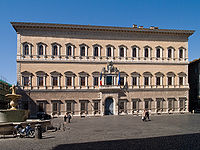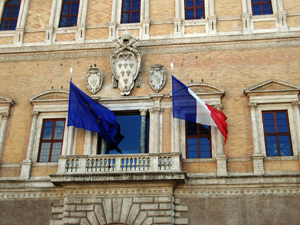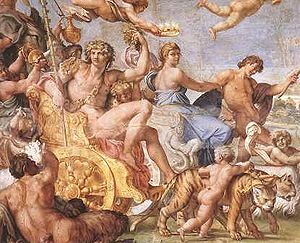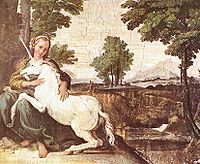
Palazzo Farnese, Rome
Encyclopedia





Renaissance
The Renaissance was a cultural movement that spanned roughly the 14th to the 17th century, beginning in Italy in the Late Middle Ages and later spreading to the rest of Europe. The term is also used more loosely to refer to the historical era, but since the changes of the Renaissance were not...
palace in Rome
Rome
Rome is the capital of Italy and the country's largest and most populated city and comune, with over 2.7 million residents in . The city is located in the central-western portion of the Italian Peninsula, on the Tiber River within the Lazio region of Italy.Rome's history spans two and a half...
, which currently houses the French
France
The French Republic , The French Republic , The French Republic , (commonly known as France , is a unitary semi-presidential republic in Western Europe with several overseas territories and islands located on other continents and in the Indian, Pacific, and Atlantic oceans. Metropolitan France...
embassy and the Ecole Française de Rome (the French Historical Roman Institute).
First designed in 1517 for the Farnese family, the palace building expanded in size and conception when Alessandro Farnese became Pope Paul III
Pope Paul III
Pope Paul III , born Alessandro Farnese, was Pope of the Roman Catholic Church from 1534 to his death in 1549. He came to the papal throne in an era following the sack of Rome in 1527 and rife with uncertainties in the Catholic Church following the Protestant Reformation...
in 1534, to designs by Antonio da Sangallo the Younger
Antonio da Sangallo the Younger
thumb|250px|The church of Santa Maria di Loreto near the [[Trajan's Market]] in [[Rome]], considered Sangallo's masterwork.thumb|250px|View of St. Patrick's Well in [[Orvieto]]....
, its building history involved some of the most prominent Italian architects of the 16th century, including Antonio da Sangallo the Younger, Michelangelo
Michelangelo
Michelangelo di Lodovico Buonarroti Simoni , commonly known as Michelangelo, was an Italian Renaissance painter, sculptor, architect, poet, and engineer who exerted an unparalleled influence on the development of Western art...
, Jacopo Barozzi da Vignola and Giacomo della Porta
Giacomo della Porta
Giacomo della Porta was an Italian architect and sculptor, who worked on many important buildings in Rome, including St. Peter's Basilica. He was born at Porlezza, Lombardy and died in Rome.-Biography:...
.
At the end of the 16th century, the important fresco cycle of The Loves of the Gods
The Loves of the Gods (Carracci)
The Loves of the Gods is a monumental fresco cycle, completed by the Bolognese artist Annibale Carracci and his studio, in the Farnese Gallery which is located in the west wing of the Palazzo Farnese, now the French Embassy) in Rome, Italy...
in the Farnese Gallery was carried out by the Bolognese painter Annibale Carracci
Annibale Carracci
Annibale Carracci was an Italian Baroque painter.-Early career:Annibale Carracci was born in Bologna, and in all likelihood first apprenticed within his family...
, marking the beginning of two divergent trends in painting during the 17th century, the Roman High Baroque
Baroque
The Baroque is a period and the style that used exaggerated motion and clear, easily interpreted detail to produce drama, tension, exuberance, and grandeur in sculpture, painting, literature, dance, and music...
and Classicism
Classicism
Classicism, in the arts, refers generally to a high regard for classical antiquity, as setting standards for taste which the classicists seek to emulate. The art of classicism typically seeks to be formal and restrained: of the Discobolus Sir Kenneth Clark observed, "if we object to his restraint...
. The famous Farnese sculpture collection, now in the National Archeological Museum of Naples, as well as other Farnese collections, now mostly in Capodimonte Museum in Naples
Naples
Naples is a city in Southern Italy, situated on the country's west coast by the Gulf of Naples. Lying between two notable volcanic regions, Mount Vesuvius and the Phlegraean Fields, it is the capital of the region of Campania and of the province of Naples...
, were accommodated in the palace.
History
"The most imposing ItalianItaly
Italy , officially the Italian Republic languages]] under the European Charter for Regional or Minority Languages. In each of these, Italy's official name is as follows:;;;;;;;;), is a unitary parliamentary republic in South-Central Europe. To the north it borders France, Switzerland, Austria and...
palace
Palace
A palace is a grand residence, especially a royal residence or the home of a head of state or some other high-ranking dignitary, such as a bishop or archbishop. The word itself is derived from the Latin name Palātium, for Palatine Hill, one of the seven hills in Rome. In many parts of Europe, the...
of the 16th century", according to Sir Banister Fletcher, this palace was designed by Antonio da Sangallo the Younger
Antonio da Sangallo the Younger
thumb|250px|The church of Santa Maria di Loreto near the [[Trajan's Market]] in [[Rome]], considered Sangallo's masterwork.thumb|250px|View of St. Patrick's Well in [[Orvieto]]....
, one of Bramante's assistants in the design of St. Peter's
St. Peter's Basilica
The Papal Basilica of Saint Peter , officially known in Italian as ' and commonly known as Saint Peter's Basilica, is a Late Renaissance church located within the Vatican City. Saint Peter's Basilica has the largest interior of any Christian church in the world...
and an important Renaissance architect in his own right. Construction began in 1515 after one or two years of preparation, and was commissioned by Alessandro Farnese
Pope Paul III
Pope Paul III , born Alessandro Farnese, was Pope of the Roman Catholic Church from 1534 to his death in 1549. He came to the papal throne in an era following the sack of Rome in 1527 and rife with uncertainties in the Catholic Church following the Protestant Reformation...
, who had been appointed as a cardinal
Cardinal (Catholicism)
A cardinal is a senior ecclesiastical official, usually an ordained bishop, and ecclesiastical prince of the Catholic Church. They are collectively known as the College of Cardinals, which as a body elects a new pope. The duties of the cardinals include attending the meetings of the College and...
in 1493 at age 25 and was living a princely lifestyle. Work was interrupted by the Sack of Rome in 1527
Sack of Rome (1527)
The Sack of Rome on 6 May 1527 was a military event carried out by the mutinous troops of Charles V, Holy Roman Emperor in Rome, then part of the Papal States...
.
When, in January 1534, Cardinal Alessandro became Pope Paul III, the size of the palace was increased significantly and he employed Michelangelo who completed the redesigned third story with its deep cornice and revised the courtyard as well. The post-1534 developments were not only a reflection of Alessandro's change in status but employed architecture to express the power of the Farnese family, much as at their Villa Farnese
Villa Farnese
The Villa Farnese, also known as Villa Caprarola, is a mansion in the town of Caprarola in the province of Viterbo, Northern Lazio, Italy, approximately 50 kilometres north-west of Rome...
at Caprarola. The massive palace block and its facade dominate the Piazza Farnese.
Architectural features of the main facade include the alternating triangular and segmental pediments that cap the windows of the piano nobile
Piano nobile
The piano nobile is the principal floor of a large house, usually built in one of the styles of classical renaissance architecture...
, the central rusticated portal and Michelangelo's projecting cornice which throws a deep shadow on the top of the facade. Michelangelo revised the central window in 1541, adding an architrave to give a central focus to the facade, above which is the largest papal stemma, or coat-of-arms with papal tiara, Rome had ever seen. When Paul appeared on the balcony, the entire facade became a setting for his person. The courtyard, initially open arcades, is ringed by an academic exercise in ascending orders (Doric
Doric order
The Doric order was one of the three orders or organizational systems of ancient Greek or classical architecture; the other two canonical orders were the Ionic and the Corinthian.-History:...
, Corinthian
Corinthian order
The Corinthian order is one of the three principal classical orders of ancient Greek and Roman architecture. The other two are the Doric and Ionic. When classical architecture was revived during the Renaissance, two more orders were added to the canon, the Tuscan order and the Composite order...
, and Ionic
Ionic order
The Ionic order forms one of the three orders or organizational systems of classical architecture, the other two canonic orders being the Doric and the Corinthian...
). The piano nobile entablature was given a frieze with garlands, added by Michelangelo.
On the garden side of the palace, which faced the River Tiber, Michelangelo proposed the innovatory design of a bridge which, if completed, would have linked the palace with the gardens of the Vigna Farnese, Alessandro's holding on the opposite bank, that later became incorporated into the adjacent villa belonging to the Chigi
Chigi
Chigi may refer to:* Chigi , a crossbreed between a Welsh Corgi and a chihuahua * House of Chigi, a Roman princely family* Chigi , an element in Japanese architecture...
family, which the Farnese purchased in 1584 and renamed the Villa Farnesina
Villa Farnesina
The Villa Farnesina is a Renaissance suburban villa in the Via della Lungara, in the district of Trastevere in Rome, central Italy.The villa was built for Agostino Chigi, a rich Sienese banker and the treasurer of Pope Julius II. Between 1506–1510, the Sienese artist and pupil of Bramante,...
. While the practicalities of achieving this bridge remain dubious, the idea was a bold and expansive one.
During the 16th century, two large granite basins from the Baths of Caracalla
Baths of Caracalla
The Baths of Caracalla in Rome, Italy were Roman public baths, or thermae, built in Rome between AD 212 and 216, during the reign of the Emperor Caracalla.- History :...
were adapted as fountains in the Piazza Farnese, the "urban" face of the palace.
The palazzo
Palazzo
Palazzo, an Italian word meaning a large building , may refer to:-Buildings:*Palazzo, an Italian type of building**Palazzo style architecture, imitative of Italian palazzi...
was further modified for the papal nephew Ranuccio Farnese by Jacopo Barozzi da Vignola. It was completed for the second Cardinal Alessandro Farnese by Giacomo della Porta
Giacomo della Porta
Giacomo della Porta was an Italian architect and sculptor, who worked on many important buildings in Rome, including St. Peter's Basilica. He was born at Porlezza, Lombardy and died in Rome.-Biography:...
's porticoed facade towards the Tiber
Tiber
The Tiber is the third-longest river in Italy, rising in the Apennine Mountains in Emilia-Romagna and flowing through Umbria and Lazio to the Tyrrhenian Sea. It drains a basin estimated at...
which was finished in 1589.
Following the death of Cardinal Odoardo Farnese in 1626, the palazzo stood virtually uninhabited for twenty years. At the conclusion of the War of Castro with the papacy, Duke Odoardo
Odoardo Farnese
Odoardo Farnese was Duke of Parma and Piacenza from 1622 to 1646.-Biography:Odoardo was the sole legitimate son of Ranuccio I Farnese and Margherita Aldobrandini...
was able to regain his family properties, which had been sequestered. The resulting inventory (see below) is the oldest surviving complete inventory of Palazzo Farnese.
After Odoardo's death, Pope Alexander VII
Pope Alexander VII
Pope Alexander VII , born Fabio Chigi, was Pope from 7 April 1655, until his death.- Early life :Born in Siena, a member of the illustrious banking family of Chigi and a great-nephew of Pope Paul V , he was privately tutored and eventually received doctorates of philosophy, law, and theology from...
allowed Queen Christina of Sweden
Christina of Sweden
Christina , later adopted the name Christina Alexandra, was Queen regnant of Swedes, Goths and Vandals, Grand Princess of Finland, and Duchess of Ingria, Estonia, Livonia and Karelia, from 1633 to 1654. She was the only surviving legitimate child of King Gustav II Adolph and his wife Maria Eleonora...
to lodge in the palace for several months, but she "proved a tenant from hell". After her departure for Paris, the papal authorities discovered that her unruly servants not only had stolen the silver, tapestries, and paintings, but also had "smashed up doors for firewood" and removed sections of copper roofing.
Interior decorations
Several main rooms were frescoFresco
Fresco is any of several related mural painting types, executed on plaster on walls or ceilings. The word fresco comes from the Greek word affresca which derives from the Latin word for "fresh". Frescoes first developed in the ancient world and continued to be popular through the Renaissance...
ed with elaborate allegorical programs including the Hercules
Hercules
Hercules is the Roman name for Greek demigod Heracles, son of Zeus , and the mortal Alcmene...
cycle in the Sala d'Ercole or the Hercules Room, and the well known The Loves of the Gods
The Loves of the Gods (Carracci)
The Loves of the Gods is a monumental fresco cycle, completed by the Bolognese artist Annibale Carracci and his studio, in the Farnese Gallery which is located in the west wing of the Palazzo Farnese, now the French Embassy) in Rome, Italy...
(1597-1608) in the Farnese Gallery, both by the Bolognese painter Annibale Carracci
Annibale Carracci
Annibale Carracci was an Italian Baroque painter.-Early career:Annibale Carracci was born in Bologna, and in all likelihood first apprenticed within his family...
. Other rooms have frescoes by Daniele da Volterra
Daniele da Volterra
Daniele Ricciarelli , better known as Daniele da Volterra, was an Italian mannerist painter and sculptor.He is best remembered for his association, for better or worse, with the late Michelangelo. Several of Daniele's most important works were based on designs made for that purpose by Michelangelo...
and by other artist
Artist
An artist is a person engaged in one or more of any of a broad spectrum of activities related to creating art, practicing the arts and/or demonstrating an art. The common usage in both everyday speech and academic discourse is a practitioner in the visual arts only...
s.
For generations, the room with Herculean frescoes accommodated the famous Greco-Roman antique sculpture known as the Farnese Hercules
Farnese Hercules
The Farnese Hercules is an ancient sculpture, probably an enlarged copy made in the early third century AD and signed by a certain Glykon, from an original by Lysippos that would have been made in the fourth century BC...
. Other works from the family collection of classical sculpture were also housed in the palace.
One of the vault and ceiling fresco by Annibale Carracci is Galleria Farnese, an art gallery. According to Ann Sutherland Harris, "The Galleria frescoes make even more extensive use of ancient sculptural and architectural sources, and in addition take their basic structure from two ceilings by the most prestigious artists of the High Renaissance in Rome, the Loggia of Psyche by Raphael and Michelangelo's Sistine Chapel ceiling". Carracci adopted the quadri riportati, which the ceiling is divided into units and turned it into a collection of framed paintings, along with the cast masks among the garlands, and carved putti, and sculptures supporting the central scene. This large central scene depicts the triumphal progress of Bacchus and Ariadne. Two smaller paintings are attached to the top and bottom of the central picture, and two vertical pictures on either side, filled with sphinxes, Pan, and two satyrs.
Imitators
The Palazzo's design has been mimicked in several buildings outside Italy, including the Château GrimaldiChâteau Grimaldi (Puyricard)
Château Grimaldi at Puyricard near Aix-en-Provence is a mansion built within the ruined walls of a 16th century Château once belonging to the Archbishops of Puyricard. The original castle chapel remains built in the Romanesque style...
near Aix-en-Provence
Aix-en-Provence
Aix , or Aix-en-Provence to distinguish it from other cities built over hot springs, is a city-commune in southern France, some north of Marseille. It is in the region of Provence-Alpes-Côte d'Azur, in the département of Bouches-du-Rhône, of which it is a subprefecture. The population of Aix is...
, in England Charles Barry
Charles Barry
Sir Charles Barry FRS was an English architect, best known for his role in the rebuilding of the Palace of Westminster in London during the mid-19th century, but also responsible for numerous other buildings and gardens.- Background and training :Born on 23 May 1795 in Bridge Street, Westminster...
's great admiration for the building led him to use it as the model for London's Reform Club
Reform Club
The Reform Club is a gentlemen's club on the south side of Pall Mall, in central London. Originally for men only, it changed to include the admission of women in 1981. In 2011 the subscription for membership of the Reform Club as a full UK member is £1,344.00, with a one-off entrance fee of £875.00...
, France, the National Building Museum
National Building Museum
The National Builders Museum, in Washington, D.C., United States, is a museum of "architecture, design, engineering, construction, and urban planning"...
in Washington, D.C.
Washington, D.C.
Washington, D.C., formally the District of Columbia and commonly referred to as Washington, "the District", or simply D.C., is the capital of the United States. On July 16, 1790, the United States Congress approved the creation of a permanent national capital as permitted by the U.S. Constitution....
, USA, and the Chief Secretary’s Building
Chief Secretary’s Building
The Chief Secretary’s Building is an historic Sydney landmark located at 121 Macquarie Street, 65 Bridge Street and 44-50 Phillip Street....
in Sydney
Sydney
Sydney is the most populous city in Australia and the state capital of New South Wales. Sydney is located on Australia's south-east coast of the Tasman Sea. As of June 2010, the greater metropolitan area had an approximate population of 4.6 million people...
, Australia. Also, the Royal Palace, Stockholm was inspired by the Palazzo Farnese.
Puccini's Tosca
In PucciniGiacomo Puccini
Giacomo Antonio Domenico Michele Secondo Maria Puccini was an Italian composer whose operas, including La bohème, Tosca, Madama Butterfly, and Turandot, are among the most frequently performed in the standard repertoire...
's opera
Opera
Opera is an art form in which singers and musicians perform a dramatic work combining text and musical score, usually in a theatrical setting. Opera incorporates many of the elements of spoken theatre, such as acting, scenery, and costumes and sometimes includes dance...
Tosca
Tosca
Tosca is an opera in three acts by Giacomo Puccini to an Italian libretto by Luigi Illica and Giuseppe Giacosa. It premiered at the Teatro Costanzi in Rome on 14 January 1900...
(1900), set in Napoleonic Rome, the heroine's confrontation with the malevolent Chief of Police
Chief of police
A Chief of Police is the title typically given to the top official in the chain of command of a police department, particularly in North America. Alternate titles for this position include Commissioner, Superintendent, and Chief constable...
, Scarpia, takes place in Palazzo Farnese. The Palazzo was inherited from the Farnese by the Bourbon
House of Bourbon
The House of Bourbon is a European royal house, a branch of the Capetian dynasty . Bourbon kings first ruled Navarre and France in the 16th century. By the 18th century, members of the Bourbon dynasty also held thrones in Spain, Naples, Sicily, and Parma...
kings of Naples
Naples
Naples is a city in Southern Italy, situated on the country's west coast by the Gulf of Naples. Lying between two notable volcanic regions, Mount Vesuvius and the Phlegraean Fields, it is the capital of the region of Campania and of the province of Naples...
, from whom the French government
French Third Republic
The French Third Republic was the republican government of France from 1870, when the Second French Empire collapsed due to the French defeat in the Franco-Prussian War, to 1940, when France was overrun by Nazi Germany during World War II, resulting in the German and Italian occupations of France...
purchased it in 1874. Though the government of Benito Mussolini
Benito Mussolini
Benito Amilcare Andrea Mussolini was an Italian politician who led the National Fascist Party and is credited with being one of the key figures in the creation of Fascism....
ransomed it in 1936, the French Embassy remains, under a 99-year lease
Concession (territory)
In international law, a concession is a territory within a country that is administered by an entity other than the state which holds sovereignty over it. This is usually a colonizing power, or at least mandated by one, as in the case of colonial chartered companies.Usually, it is conceded, that...
for which they pay the Italian Government a symbolic fee of 1 euro per month.
Palazzo Farnese library
The Palazzo Farnese houses the great scholarly library amassed by the Ecole Française de Rome, concentrating especially on the archeology of Italy and medieval Papal history. The Ecole Française de Rome embarked on a massive project of publishing as much of the documentation of the constructing of the palazzo, its frescoes and furnishings, library and works of art, fully annotated and indexed. The first three volumes are:- F.C. Uginet, Le palais farnèse à travers les documents financiers (Rome 1980).
- A. Chastel, Le Palais Farnèse. Ecole Française de Rome I.1 and I.2 and II (Rome 1980-82).
- F. Fossier. Le Palais Farnèse III.2. La bibliothèque Farnèse. Étude des manuscrits latins et en langue vernaculaire (Rome 1982).
- B. Jestaz, Le Palais Farnèse III.3. L'inventaire du palais et des propriéeés Farnèse à Rome en 1644 (Rome 1994)
External links
- Mostra Palazzo Farnese exhibition in the Palazzo Farnese
- Romeartlover site with 1765 print by Giuseppi Vasi
- Romeartlover entry for Farnese
- Satellite photo- The Palazzo Farnese is the massive, almost square, court-yarded structure in the center of the photo, to the North of the Tiber. The smaller bracket-shaped building southwest (lower) across the Tiber is the Villa FarnesinaVilla FarnesinaThe Villa Farnesina is a Renaissance suburban villa in the Via della Lungara, in the district of Trastevere in Rome, central Italy.The villa was built for Agostino Chigi, a rich Sienese banker and the treasurer of Pope Julius II. Between 1506–1510, the Sienese artist and pupil of Bramante,...
. - Farnese Palace

